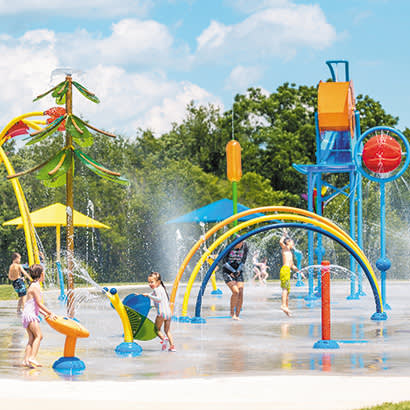
For an enhanced digital experience, read this story in the ezine.
The World Health Organization (WHO) continues to underscore the importance of community parks as they relate to family health. Kids are playing less, getting less exercise and often lack access to physical activity opportunities. As a result, the prevalence of obesity in children has approximately tripled in the past 30 years. Acknowledging this rise in obesity and many other chronic diseases, WHO has stressed how a child’s environment significantly determines their overall well-being.
Local parks have the power to promote a healthy lifestyle for children and families alike. As demographics, health and inclusion concerns evolve, aging facilities and new projects must step up to keep communities engaged and active.
Attracting Families
Because children’s use of parks is mainly guided by their parents and caregivers, understanding their preferences is essential for creating the most inviting and usable park spaces to facilitate children’s physical activity.
However, very few studies have been conducted to document parents’ and caregivers’ preferences. Research completed several years ago concluded that less than 50 percent of respondents frequented the park closest to their starting destination. Most traveled nearly two-and-a-half miles to the park; the park location was less important than the amenities they desired. In fact, the main reasons for choosing certain parks were water attractions, shade, swings and cleanliness.
Water Play
Splash pads have become one of the most popular methods of encouraging physical activity and much more. Of course, they develop kids’ aerobic capacity, muscular strength, agility, reflexes, coordination and motor skills. They encourage necessary free play, where activities are unscripted, and minds are open to creativity. Cognitively, children interact with the water features, and they learn — reasoning, cause and effect, and intuition. Water play is also a rich sensory experience, as kids see, touch and hear various water effects and color reflections. Splash pads encourage collaborative play that promotes teamwork, generates interaction and fosters social skills, giving children the tools to cope with stress and the means to solve problems actively.
A healthy community also means making inclusion a priority. Splash pads employ an inclusive design approach that incorporates both accessibility and universality. This means accommodating as many people as possible, regardless of age or physical or mental ability.
Healthy Communities
Perhaps the most understated element of a splash pad is its transformative power to create healthier communities by building social capital. They become vital gathering places creating safer, more connected, engaged and active communities.
Splash pads connect families. Parents and caregivers tend to get off the bench and join in the water fun more than any other play opportunity. Splash pads encourage healthy play across generations.
Splash pads connect communities. An aquatics play space becomes a destination and gathering point for neighbors. Parents can connect, and neighbors can build or strengthen ties. The presence of more individuals and families in public spaces helps to reduce crime and vandalism.
Amenities like splash pads positively impact the local economy. Towns and cities with well-designed public spaces attract businesses, which improve the local tax base and increase property values.
Splash pads have been proven to increase park usage, promote inclusion and build social capital, supporting healthy communities.
Barb Lapierre is Director of Direct Sales and Education at Vortex Aquatic Structures International.

